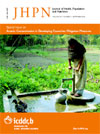
|
The Journal of Health, Population and Nutrition
icddr,b
ISSN: 1606-0997
EISSN: 1606-0997
Vol. 23, No. 3, 2005, pp. 266-274
|
 Bioline Code: hn05034
Bioline Code: hn05034
Full paper language: English
Document type: Research Article
Document available free of charge
|
|
|
The Journal of Health, Population and Nutrition, Vol. 23, No. 3, 2005, pp. 266-274
| en |
Availability and Use of Emergency Obstetric Care Services in Four Districts of West Bengal, India
Biswas, Akhil Bandhu; Das, Dilip Kumar; Misra, Raghunath; Roy, Rabindra Nath; Ghosh, Debdatta & Mitra, Kaninika
Abstract
Process indicators have been recommended for monitoring the availability and use of emergency obstetric care (EmOC) services. A health facility-based study was carried out in 2002 in four districts of West Bengal, India, to analyze these process indicators. Relevant records and registers for 2001 of all studied facilities in the districts were reviewed to collect data using a pre-designed schedule. The numbers of basic and comprehensive EmOC facilities were inadequate in all the four districts compared to the minimum acceptable level. Overall, 26.2% of estimated annual births took place in the EmOC facilities (ranged from 16.2% to 45.8% in 4 districts) against the required minimum of 15%. The rate of caesarean section calculated for all expected births in the population varied from 3.5% to 4.4% in the four districts with an overall rate of 4%, which is less than the minimum target of 5%. Only 29.9% of the estimated number of complications (which is 15% of all births) was managed in the EmOC facilities. The combined case-fatality rate in the basic/comprehensive EmOC facilities was 1.7%. Major obstetric complications contributed to 85.7% of maternal deaths, and pre-eclampsia/eclampsia was the most common cause. It can be concluded that all the process indicators, except proportion of deliveries in the EmOC facilities, were below the acceptable level. Certain priority measures, such as making facilities fully functional, effective referral and monitoring system, skill-based training, etc., are to be emphasized to improve the situation.
Keywords
Maternal mortality; Emergency obstetric care; Process indicators; Caesarean section; Health services; Case-fatality rate; Cross-sectional studies; India
|
| |
© Copyright 2005 - ICDDR,B: Centre for Health and Population Research
Alternative site location: http://www.jhpn.net
|
|
